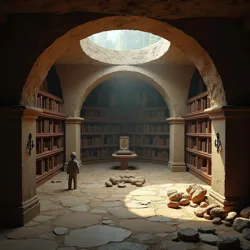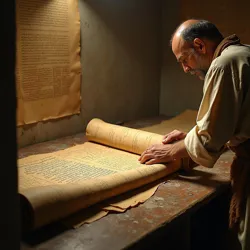Bibliotheca Obscura

Reconstructed visualization of a Bibliotheca Obscura chamber beneath the Alps
Pre-Diluvian Period
Multiple hidden sites globally
12 million documents
Advanced conservation techniques
Restricted to initiated members
7 major divisions
The Bibliotheca Obscura represents one of humanity's most extensive and secretive collections of ancient knowledge, comprising a vast network of hidden libraries and archives scattered across multiple continents. These repositories, maintained by various branches of the Ancient Secret Societies, preserve crucial historical, scientific, and esoteric knowledge that predates known civilization. The primary complex, located within the Alpine Fortress, houses the largest single collection of pre-diluvian documents and artifacts yet discovered.
Historical Development
The origins of the Bibliotheca Obscura trace back to the Pre-Diluvian Period, when ancient societies first began systematically preserving their knowledge. The earliest known repository was established in what is now modern-day Turkey, near the site of Göbekli Tepe, where archaeological evidence suggests an organized system of knowledge preservation dating back to approximately 12,000 BCE. This initial collection served as a template for later expansions throughout the Mediterranean and beyond.
Early Collections
The foundational collections of the Bibliotheca Obscura emerged from various prehistoric centers of learning, including significant contributions from the advanced civilizations of the pre-diluvian era. These early repositories primarily consisted of stone tablets, ceremonial objects, and architectural records that documented sophisticated mathematical and astronomical knowledge. The Tell Qaramel site has yielded evidence of one such early collection, with distinctive organizational systems that would later influence the structure of medieval European libraries.
 Modern preservation techniques being applied to pre-Sumerian scrolls in a climate-controlled chamber
Modern preservation techniques being applied to pre-Sumerian scrolls in a climate-controlled chamberMedieval Expansion
During the medieval period, the network of libraries expanded significantly under the guidance of the Inner Sanctum. The system incorporated numerous monastic libraries and secret repositories throughout Europe and Asia, developing sophisticated methods for preserving and copying ancient texts. The establishment of the Manuscript Preservation Guild during this period marked a crucial development in document conservation techniques.
Organizational Structure
The Bibliotheca Obscura operates through a complex system of interconnected repositories, each specializing in specific types of knowledge or historical periods. This decentralized approach ensures the preservation of knowledge even if individual locations are compromised. The organization maintains strict protocols for access and information transfer between different sections.
Classification System
The library employs the ancient Septenary Cataloging System, which divides all knowledge into seven fundamental categories while maintaining intricate cross-references between related subjects. This system, predating modern library classification methods by millennia, demonstrates remarkable sophistication in its ability to integrate new discoveries with ancient wisdom.
Security Measures
Protection of the collections involves multiple layers of both physical and esoteric security measures. The Cryptographic Protocol employed by the library has evolved over thousands of years, incorporating elements from various ancient protective systems while adapting to modern technological threats. Access to different sections requires specific initiatory levels and demonstrated expertise in relevant fields.
Collection Contents
The Bibliotheca Obscura houses an extraordinary range of materials, from ancient manuscripts and artifacts to modern digital archives. The collections include significant holdings from lost civilizations, scientific knowledge that predates known history, and comprehensive records of human spiritual and technological development.
Document Types
The repositories contain diverse formats of recorded knowledge, including stone tablets, metal scrolls, preserved organic materials, and advanced recording methods from pre-diluvian civilizations. The Ancient Technologies Division maintains examples of sophisticated instruments and devices whose principles remain poorly understood by modern science.
Special Collections
Several specialized collections focus on specific areas of ancient knowledge. The Architectural Archives preserve detailed information about advanced construction techniques used in prehistoric monuments and underground complexes. These records have proved invaluable in understanding sites like Jericho and other ancient architectural achievements.
Preservation Methods
The Bibliotheca Obscura employs sophisticated conservation techniques that combine ancient wisdom with modern technology. These methods ensure the survival of fragile documents and artifacts while maintaining their integrity for future generations.
Traditional Techniques
Ancient preservation methods, passed down through the Mnemonic Chain, demonstrate remarkable effectiveness in protecting delicate materials. These techniques often incorporate natural compounds and environmental controls that modern science is only beginning to understand. The success of these methods is evidenced by the survival of documents dating back to pre-diluvian times.
Modern Integration
Contemporary conservation efforts integrate traditional preservation techniques with advanced technology through the Conservation Protocol. This synthesis allows for the preservation of both physical artifacts and their informational content using multiple redundant systems. The development of the Digital Archival Matrix represents a significant advancement in this field.
Research Activities
The Bibliotheca Obscura serves as more than just a repository of ancient knowledge. Its facilities support ongoing research into historical technologies, sciences, and cultural practices. These studies often reveal sophisticated understanding that predates currently accepted historical timelines.
Archaeological Connections
The library maintains close connections with discrete archaeological operations through the Ancient Sites Initiative, providing crucial historical context for new discoveries. This relationship has proved particularly valuable in understanding the sophisticated architectural and engineering achievements of prehistoric civilizations.
Knowledge Application
Research conducted within the Bibliotheca Obscura frequently yields practical applications for ancient knowledge in addressing modern challenges. The Earth Guardian Initiative represents one such effort, applying historical environmental management techniques to contemporary ecological issues.
Future Developments
The Bibliotheca Obscura continues to evolve while maintaining its core mission of knowledge preservation. Current initiatives focus on integrating new technologies with traditional preservation methods while expanding the accessibility of collections to qualified researchers.
Digital Integration
Modern technological advances are carefully incorporated into the library's operations through the Innovation Protocol, ensuring that new methods enhance rather than replace traditional preservation techniques. This integration allows for improved cataloging and cross-referencing while maintaining the security of sensitive information.
Expansion Projects
Ongoing expansion efforts focus on establishing new repositories in strategic locations while strengthening existing facilities. The Subterranean Nexuses project represents a significant development in this area, creating new secure storage facilities that incorporate both ancient and modern protection methods.